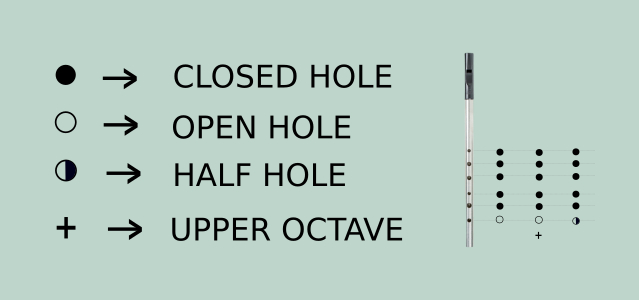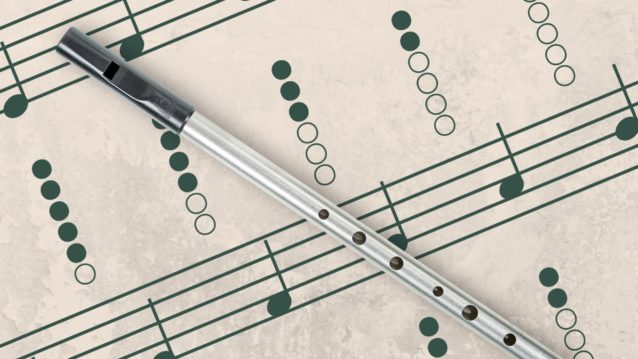This guide applies to six-hole woodwind instruments such as the Irish tin whistle (penny whistle), low whistle, or Irish flute. It explains the basics of the whistle as an instrument and guides you through all of its scales and keys. Letter notes and fingering charts will also help understand how to read tin whistle tabs, particularly useful for those unfamiliar with sheet music notation.
Tin whistle notes, keys and scales
Tin whistles are made in all major keys. But unlike some classical music instruments (i.e. clarinet or flute) that can play all notes (chromatic scales), an Irish tin whistle can play only one standard (diatonic) musical scale of seven notes per key. Actually, two scales, by using a special cross-fingering for an additional note (you will read more about it soon). It means that you will need several different whistles to cover every song in its original key. Or, if you are likely to play with a band, you probably need different whistle keys to match the other musicians and their instruments.
If you are just getting started, you probably want to follow the fingering guide and notes for a whistle in the key of D. It is the most common key and probably the first whistle among beginner whistles you should get, as most tunes and songs are played in this specific key. At least in terms of Irish traditional music.
Holes & fingers placement
Regarding finger position, you should cover the holes with the three middle fingers of both hands. Your strong hand usually goes to the bottom and the other one on top. There is also a tutorial on this website that explains how to hold a tin whistle correctly in more detail. You may want to check it out as well as other helpful whistle lessons.
How many octaves a tin whistle can play?
The tin whistle has two octaves (usually named lower and upper). And while the fingering is the same for both of them, you reach the upper octave by blowing harder. There is an exception for the tonic (root) note itself, which is available in 3 octaves. So, on a D whistle, you have a note D in its third octave too.
How to read tin whistle finger charts (tabs)
The simple graphic below should help to avoid any confusion about reading all of the charts on this page and any other tin whistle notes guide that you may come across.
The dark circle represents the holes covered with your fingers. The light circle is for open holes. And there are also rare cases where you may want to half-cover the hole for semitones. The plus sign means that the note is in the upper octave, the fingering is the same, but you blow harder to reach it.

Tin whistle notes & fingering chart – key of D
D is the most common key among both high whistles and low whistles.

Below is a video featured in our lessons demonstrating the D scale on a tin whistle.
Playing “C natural” note on a D whistle
It would help if you had in mind that every whistle, regardless of its key, has another note that doesn’t naturally belong in the scale but can be played too. This special note is usually referred to as the crossing note or the flat 7th. On a D whistle, this is note C, which is a note between B and C# (notes 6 and 7). That way, it means you can play another scale (key) on the same whistle. So, having a note C available on a D whistle, you can play both D and G scales.
Below is the fingering chart for the “special” C note. There are a couple of finger position alternatives, as the pitch of that note varies depending on the whistle and its lower/upper octave.

Tin whistle finger chart & notes – key of C

C is a widespread whistle key for a high Irish whistle, but a couple of brands offer a low C whistle. You can also play the F scale by using a special note B flat (Bb) on a C whistle.
A whistle finger chart & notes

Whistle in the key of A is a medium-sized, somewhere between a high and a low whistle, sometimes it’s called Alto A whistle. You can also play the D scale by using special fingering for the note G on an A whistle.
B flat (Bb/A#) whistle finger chart & notes

Bb whistle is also a standard tin whistle key offered by many manufacturers. By using special fingering for the note G#, playing the Eb scale is possible.
B whistle chart

Whistles in the key of B are rare and not available among most of the whistle makers. The special fingering can be used for note A, providing a way to play the E scale.
C sharp (C#) whistle chart

Whistle in the key of C# is also very rare and not a standard one. By using special fingering for the note B, you can play F# scale.
E flat (Eb/D#) whistle chart

Whistle in the key of E flat (Eb) is a many players’ choice. And that applies to both high and low whistles. Its specific pitch usually provides a slightly more sharp and crispier tone than a regular D whistle by the same brand. By using special fingering for the note C#, you get Ab scale available fro playing too.
E whistle chart

E whistle is usually a low whistle. However, some brands offer high E whistles as well. By playing a special note D, you have A scale playable too.
F whistle chart

F whistle is more often found as a low whistle, but sometimes it is available as a high whistle too. Special fingering can be used for the note D#/Eb which provides a possibility to play Bb scale.
F sharp (F#) whistle chart

An F sharp whistle is rare to find. However, there are a couple of brands that offer them. Special fingering note is note E which provides a possibility to play B scale too.
G whistle chart

G whistles are more used as low (alto) whistles. By playing a special fingering note F, you get C scale available with it too.
A flat (Ab/G#) whistle chart

A very rare key of Ab (or G#). Not available as a high whistle at all. By playing special fingering for the note F#, the scale C# is available too.
Tin whistle “all keys and notes” matrix chart
Feel free to download our full tin whistle matrix chart, including all keys and letter notes in one place.




